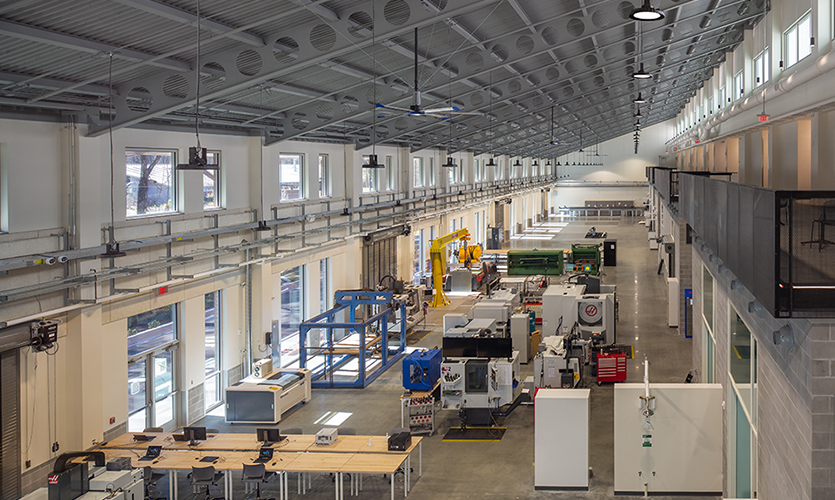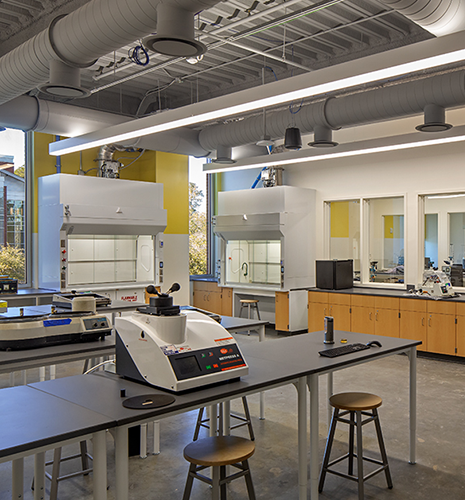Engineering Research Building
Georgia Southern University

SSOE, in association with design partner SmithGroup, partnered with Georgia Southern University on the design and implementation of their state-of-the-art Engineering Research Building. The facility has been designed for success through supporting regional business and industry, and institutional evolution by supporting new and future interdisciplinary opportunities through long-term conversion from academic to research laboratories. The three-story building is the largest building on campus; however, great care was taken to ensure it fits in well with its context. The building provides a new visual center for the University’s newly created and rapidly growing Manufacturing Engineering Department, as this interdisciplinary research facility includes Mechanical Engineering, Computer, Electrical, and Civil Engineering components.
To support the University and the Paulson College of Engineering and Computing now and into the future, the facility is designed to allow laboratories that are currently focused on academics to easily become research-oriented laboratories. There are 33 unique laboratories ranging from Additive Manufacturing (Metallic 3D Printing), Industrial Robotics and Automation, Nanomaterials, Bio-Additive Manufacturing, a Clean Lab, and an open rooftop lab space. One of the most striking spaces is a high bay multi-user research lab that is the length of a football field. The facility also includes a number of supporting classrooms; graduate student, faculty, and administrative office spaces; and a conferencing-event space to host a wide variety of events. A designated tour route provides views into the labs and high bay overlooks that showcase the ongoing research for local and regional business and industry partners.




Have a question regarding our services? Need assistance with an upcoming project? Send us an email. We look forward to hearing from you and will follow up soon.
© SSOE GROUP 1948-2025
Legal | Privacy Policy | CA Privacy Policy | Cookie Policy
Website designed and developed by
Raincastle Communications, Inc.

 Dr. Bobbie Bailey and Family Performance Center
Dr. Bobbie Bailey and Family Performance CenterAutodesk Construction Cloud (ACC) is SSOE’s enterprise-wide project delivery platform. We partner with the Autodesk Product team and have research access. Use of the AI Assistant allows our design teams, owners, and general contractors the ability to query the project specifications for quality, answers, and more rapid responses to RFIs, submittals, or issues.
SSOE has developed a proof-of-concept to use an AI Agent to act as a Master Engineer and Architect trained in SSOE’s processes, best-known-methods, and trainings. Our data structure is being remodeled to enable better use of our proprietary knowledge to train the agent on the ‘SSOE way’.
SSOE is actively piloting AI Chat large language models (LLMs) or copilots that use Natural Language Processing (NLP) to streamline both design and development tasks, transforming how our teams interact with software and each other.
By integrating chat LLM engines into platforms like Revit, we’re enabling users to prompt complex actions using simple, conversational commands. In Revit, this means automating tasks such as modeling elements, cleaning up parameter data, managing annotations and dimensions, and organizing sheets—without writing scripts. These automations and quality prompts can be shared across project teams, accelerating workflows and reducing manual effort.
Similarly, our internal Software Development Community is leveraging GitHub Copilot to expedite coding tasks. Developers can generate and refine code using NLP prompts, tapping into GitHub’s extensive Repo to move faster from concept to implementation.
Together, these tools represent a shift from traditional, expert-driven scripting to intuitive, AI-assisted automation, unlocking new levels of efficiency and scalability across our projects.
We helped our client visualize and optimize façade design for occupant comfort—long before breaking ground through the use of the Autodesk Forma tool. It allows the designer to rapidly experiment with the building’s geometry and façade design to promote sustainability, prioritizing quality of spaces and comfort for end uses, especially in extreme climates (daylighting and microclimate analysis tools) at the project’s exact geographic location, using location-specific environmental data.
Discover how SSOE is using Autodesk Forma to improve sustainability outcomes for industrial projects: SSOE Group: Improving sustainability outcomes for industrial projects with Autodesk Forma.
SSOE is utilizing Microsoft Copilot Edge and M365 to significantly enhance work efficiency and accuracy across various departments. Copilot is accessible to all staff after training. Key areas of application include using it as a writing assistant, for idea generation, document summarization and generation, research assistant, excel assistant, programming code assistant, language translations, product comparison and data analysis. Use of Copilot has become part of the everyday life of SSOE employees who have identified key ways it can help them become more efficient with their daily tasks as well as more accurate in their deliverables.
Today, 100% of SSOE employees have taken the voluntary training and have access to Copilot Edge, achieving early our October 1, 2025 goal.
We found ourselves in need of a more robust tool to enhance resource forecasting and staff assignment capabilities. Instead of waiting for the perfect tool, we’re building it. SSOE’s in-house technology team has developed and piloted a tool that aims to forecast optimal staff mix and duration for new projects against existing workload to better understand capacity and manage resources efficiently. Additionally, the tool will allow teams to identify gaps to optimal staff mix.